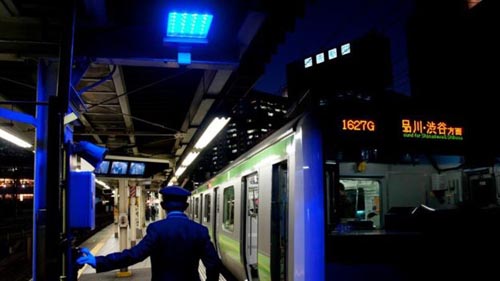车站的蓝灯真的能防止自杀吗?
In 2013, a scientific paper was published that would become the seed for thousands of viral news stories and social media posts. The suggestion was astounding: blue lamps at train stations prevented suicides at those locations. And scientists could even show that the suicides fell by as much as 84%.
2013年,一篇科学论文引发了数千篇连环新闻报道和社交媒体的讨论。论文的结论令人吃惊:火车站的蓝色灯光能减少自杀人数。科学家甚至计算出装有蓝光的车站自杀率下降了84%。
The idea has since caught on, inspiring similar projects in many other countries. But as with many interesting but complex science stories, some of the details have got a little distorted as it was passed along the way.
随后,这个观点流行起来,许多国家纷纷效仿。然而,跟许多有趣但复杂的科学故事一样,这篇论文中的一些细节在传播过程中被歪曲了。
It all started in the late 2000s, when a number of Japanese railway companies began installing blue lamps above train station platforms. It was an attempt to deter people from suicide in such places – a so-called “nudge” technique. Nudge techniques are ways of influencing behaviour that, although apparently subtle, can have surprisingly large impacts.
这要从2000年代初期说起,当时,一些日本铁路公司为了阻止卧轨自杀,开始在站台上方安装蓝灯。这是一种所谓的“助推”技术,旨在通过一些因素在不知不觉中影响人们的行为,虽然看起来微不足道,但效果惊人。
The idea was that blue light can have an effect on people’s state of mind. One study in 2017 backed up this notion; it showed that people who had experienced psychological stress returned more quickly to a state of relaxation when they lay in a room bathed in blue light.
蓝光可以影响人们的精神状态。2017年的一项研究支持了这一观点。研究表明,有心理压力的人躺在洒满蓝光的房间里,能更快地恢复到放松的状态。
Michiko Ueda at Waseda University heard about the railway companies’ experiments on station platforms and was told the lamps had proved to be a success. Ueda has studied a huge range of factors that may be influencing Japan’s suicide rate – from economics to natural disasters and even discussion of celebrity suicides on Twitter. But she says her first reaction to the railway companies’ claims was scepticism. “I thought we should follow up and I decided to contact the railway company to ask if they could provide data,” she explains.
早稻田大学(Waseda University)的上田美智子(Michiko Ueda)听说了铁路公司在站台上的试验,并得知蓝灯确实成功降低了自杀率。她曾研究了一系列可能影响日本自杀率的因素,比如经济因素、自然灾害,甚至是推特上有关名人自杀的讨论。她对于铁路公司说法的第一反应是怀疑。她解释道:“我觉得应该跟进这个实验,就联系了铁路公司,问他们能否提供数据。”

After analysing 10 years’ worth of data on suicides at 71 Japanese train stations, Ueda and her colleagues found that there was some evidence of an effect on passengers. They saw an 84% reduction, a figure that was soon widely reported.
上田和她的同事分析了日本71个火车站10年来的自杀数据,发现有证据表明蓝灯确实能对乘客产生影响,自杀率下降了84%,就是很快就被广泛报道的那个数据。
Unfortunately, that’s not the whole story. When news reports about the findings came out, Masao Ichikawa at the University of Tsukuba took another look at the data. He pointed out that it was important to distinguish between data collected during the day and night at outdoor train stations. During the day, the lights may be easily missed, or even turned off.
遗憾的是,真相并非仅仅如此。当此现象被报道后,筑波大学(University of Tsukuba)的市川雅雄(Masao Ichikawa)从另一角度对数据进行了研究。他指出,区分白天和晚上在室外火车站收集的数据很关键。白天,灯容易被忽视,甚至被关掉。
Ichikawa also scrutinised a measure known as the “confidence interval”. Statistical analyses always carry an inherent uncertainty around a particular result – such as the size of this effect – and the confidence interval expresses the possible range of those values. Ichikawa noticed that the confidence in in Ueda’s paper was extremely wide: 14-97%. “Statistically very unstable,” he says. This means the actual effect could have been as low as a 14% reduction – still a significant change, but not nearly as big as the media coverage had suggested.
市川还仔细研究了一个被称为“置信区间”的指标。统计分析得出的结果总是会有一些误差,比如影响的大小,置信区间表示误差值的可能范围。市川注意到,上田研究中的置信区间十分大,从14%至97%。“这表明统计结果非常不稳定,”他说。这意味着实际效果可能会低至14%,仍然显著,但没有媒体报道的那么夸张。
He hoped his own paper, published in response the following year, would ensure that people didn’t begin thinking that blue lights were a miracle deterrent – that they somehow had an extraordinary effect on people who were considering suicide.
他希望,自己下一年发表的回应论文能够降低人们对蓝色灯光有神奇干涉效果的盲信,虽然它们在某种程度上对那些试图自杀的人产生了巨大的影响。
The installation of protective barriers and screen doors along the edges of platforms could be far more useful, says Ichikawa. However, he acknowledges that they cost a lot more than blue lights. The expense may be worth it, though, if the blue light effect turns out to be minimal.
市川说,在站台边缘安装防护栏和幕门可能会有用得多。然而,他也承认安装这些装置成本远比蓝灯高。但如果证明了蓝光效果有限,多花些钱就是值得的。
Since publishing her paper, Ueda has been stunned by the number of enquiries she gets from railway firms around the world, including Switzerland, Belgium and the UK. “It’s amazing,” she says. There are already at least two examples of blue light installations in Britain – one at a train crossing in Scotland, and there are also such lights at Gatwick airport train station.
论文发表以来,上田收到了世界各地铁路公司的询问,包括瑞士、比利时和英国,数量之多让她震惊。“太神奇了,”她说。英国已经在至少两处安装了蓝光装置——苏格兰的一个铁路行人桥和盖特威克(Gatwick)机场火车站。
But Ueda is no proponent of the schemes. “Whenever somebody asks me whether they should do blue lights or platform screen doors, I will immediately answer, ‘You should do platform screen doors’,” she says.
上田本人并不支持蓝灯。她说:“每次有人问我应该装蓝灯还是站台幕门,我都会毫不犹豫地回答,‘应该装幕门’。”
While she understands the issue of cost associated with the screen doors, she reiterates that it’s important to understand that the blue light effect may be more subtle than some think – and we still don’t know exactly what impact the lights are having.
虽然她也知道幕门成本高,但她重申,蓝灯的影响可能比人们想象的要小得多。我们现在仍然不清楚灯光到底对人们产生了什么样的影响。
For example, perhaps the installation of new, bright lights – regardless of colour – caused people to become more self-aware, thus changing their behaviour, suggests Ueda. And maybe after time the blue lights, should they be effective at preventing suicide, will fail because people will grow accustomed to them.
上田说:“也许只要安装崭新明亮的灯,不管颜色如何,都会增强人们的自我意识,从而改变他们的行为。可能过段时间,这些能防止自杀的蓝灯就会失效,因为人们渐渐习惯了它们的存在。”
Ueda is now conducting a fresh study to measure the psychological impact of blue lights, but there are already conflicting results on that point from other teams. The 2017 paper mentioned above gave credence to the idea that blue lights could be calming, but Stephen Westland, an expert in colour and design at the University of Leeds, says the lights may not influence another important factor – someone’s impulsiveness.
上田目前正在进行一项新的研究,旨在测量蓝光对人们心理的影响。但其他团队已经在这一领域得出了与之矛盾的结果。前文提到的那篇2017年的论文证实了蓝色灯光可以使人平静,但是利兹大学(University of Leeds)色彩与设计专家韦斯特兰(Stephen Westland)说,灯光可能无法影响另一种重要情绪——冲动。


















